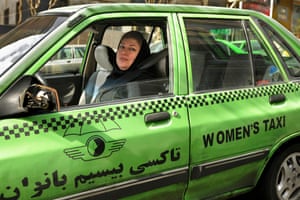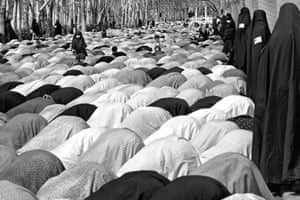In a country where the law considers homosexuality, drug-related offenses and “insulting the prophet” crimes punishable by the death penalty, freedom of expression in Iran is limited for journalists, activists and artists.
However, Iranian art is not all dark and archaic. In fact, Tehran’s cosmopolitan art scene is booming, with Sotheby’s selling $1.6m in Iranian art in one 2017 sale and Sotheby’s Dubai selling an Iranian painting for $459,000 soon after. Auction houses have also seen record-breaking sales at Bonhams, Christie’s and Sotheby’s with over $15m sold in Iranian art.
While visual artists can’t make explicit comments about certain authorities or touch upon certain themes, they manage to work it to their advantage in ways musicians, comedians and the film and TV world cannot.
Two art exhibitions – one in Los Angeles, the other in New York – have recently opened; one which dispels the misconceptions around Iranian culture, stereotypes and taboos, while the other offers a window into the lives of Iranian women. Both offer insight into how Iran has changed from the past to the present, and perhaps what the future might hold.

Southern California is home to more than 300,000 Iranians, the biggest Iranian population outside Iran. The Los Angeles County Museum of Art recently opened In the Fields of Empty Days: The Intersection of Past and Present in Iranian Art, a group exhibition featuring 125 works of art by 50 Iranian artists, including manuscripts from the 16th century, 19th-century photographs and art made during the Islamic revolution in 1979.
“I joke that it’s a show about time travel,” said Linda Komaroff, curator of Islamic art at Lacma. “The concept is how Iranian artists manipulate time, as the historical artworks in the show reveal how artists used the past to update it into the present day.”
There are portraits of Iranian world leaders by Afsoon, a London-based Iranian artist, from her 2009 series Fairytale Icons, which poses questions around Iran’s political future. “As a child I was told many fairytales of beautiful princesses and brave heroes,” says the artist. “I believed in fairytales. My chosen icons lived expectantly, hoping, wishing, dreaming. They were loved, admired and fulfilled many of their hopes and dreams. But what happened, did these fairytale icons really live happily ever after? And if not, what chance do we have of a fairytale ending?”

There are political parodies by Siamak Filizadeh, who uses symbolism to reinterpret Iranian history, and a series of cartoonish video portraits of Iranian women by the New York artist Shoja Azari. There is also a striking pink self-portrait by the Paris-based artist Malekeh Nayiny called All in Pink, a piece that’s presented as an unconventional way of addressing one’s own personal demons.
“It’s about supplying visual info to an American audience to read more and learn more about Iran,” said Komaroff. “When you think of what Iranian art might look like, it might be old-fashioned, or what you see in media coverage, but there really isn’t that; it’s exciting visual imagery that could be in any contemporary art show but it’s clearly different. The stories artists share are not based in western knowledge.
“The goal is to portray the ideas of identity, politics, faith, history and culture, which help define the remarkably diverse artistic heritage of Iran,” she adds, “viewed through the lens of time.”

Over in New York, a photo exhibition focuses on Iranian women in Iran: Women Only, which runs until 23 September at the Bronx Museum of the Arts. The solo exhibition features photos by the Bronx-born photographer Randy H Goodman, who was the first foreign female photojournalist to cover Iran in the 1980s. “The photos show an aspect of Iranian society often limited to females only,” she says.
It focuses on two periods in US-Iran relations; the US embassy takeover in 1980 and the signing of the Iran nuclear agreement in 2015, both of which Goodman covered. “Looking back to understand the socio-cultural changes happening today in Iran provides insight not only about Iranian women, but also other aspects of Iranian society,” said Goodman from her home in Cambridge, Massachusetts.
Her first trip to Iran was in 1980 when she was 24, and she returned in 2015 to find some of the same women she initially photographed. “What happened to these women?” she asks. “It was hard to get the story behind the story out.”

The photos also document how Tehran has changed; from a barren city to a real estate boom sprinkled with retail. “The city is sprawling,” said Goodman. “There are women on the streets with dyed hair and scarves pushed further back on their heads and they’re wearing designer clothing.”
In the exhibition, there’s a shot of a female taxi driver driving a women’s taxi, which transports women safely, while providing work for war widows, divorcees and other women who need to support their families. While female taxi drivers started in Tehran in 2006, more and more women are also becoming bus drivers.
There’s also a shot of a subway car for women only, which provides optional seating for women, as well as a bleak shot of praying women from the 1980s. “Things were more colorful in 2015 when I returned,” said Goodman. “There was multi-colored clothing, it seemed more stylish, it was a lighter atmosphere, as well.”
Even though Tehran can feel like a time warp to the past, Goodman notes its evolution. “Tehran has evolved into a European-like city with high-end shopping malls, social media and luxury cars,” she said. “I thought it was a valuable insight in a time when the US and Iran might be getting past some of the prior conflicts that riddled their relationship in 1953.”
- In the Fields of Empty Days: The Intersection of Past and Present in Iranian Art will be at Lacma until 9 September and Iran: Women Only will be at the Bronx Museum until 23 September